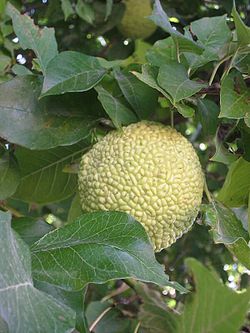Maclura pomifera: Difference between revisions
rv to Vary |
Bruce Marlin (talk | contribs) No edit summary |
||
| Line 35: | Line 35: | ||
==External links== |
==External links== |
||
*[http://www.cirrusimage.com/tree_osage_orange.htm Osage Orange - large diagnostic photographs, tree, leaves, bark, fruit] |
|||
*[http://www.na.fs.fed.us/spfo/pubs/silvics_manual/volume_2/maclura/pomifera.htm Osage-orange factsheet] from the [[United States Forest Service]] |
*[http://www.na.fs.fed.us/spfo/pubs/silvics_manual/volume_2/maclura/pomifera.htm Osage-orange factsheet] from the [[United States Forest Service]] |
||
*[http://www.ipm.iastate.edu/ipm/hortnews/1997/10-10-1997/hedgeapple.html Facts and Myths Associated with "Hedge Apples"] from an [[Iowa State University]] website |
*[http://www.ipm.iastate.edu/ipm/hortnews/1997/10-10-1997/hedgeapple.html Facts and Myths Associated with "Hedge Apples"] from an [[Iowa State University]] website |
||
Revision as of 15:54, 20 March 2006
| Osage-orange | |
|---|---|

| |
| Osage-orange foliage and fruit | |
| Scientific classification | |
| Kingdom: | |
| Division: | |
| Class: | |
| Order: | |
| Family: | |
| Genus: | Maclura
|
| Species: | M. pomifera
|
| Binomial name | |
| Maclura pomifera (Raf.) Schneid.
| |
The Osage-orange (Maclura pomifera) is a curious plant in the mulberry family Moraceae. It is also known as hedge-apple, horse-apple, hedge ball, bois d'arc, bodark (in Texas), and bow wood. A common slang term for it is also monkeybrain, due to its brainlike appearance.
The species is dioeceous, with male and female flowers on different plants. It is a small deciduous tree or large shrub, typically growing to 8-15 m tall. The fruit, a syncarp of achenes, is roughly spherical, but bumpy, and 7-15 cm in diameter, and it is filled with a sticky white sap. Fall color is a bright yellow-green with a faint orange odor.
The plant is native to an area in the central United States consisting of southwestern Arkansas, southeastern Oklahoma, a narrow belt in eastern Texas, and the extreme northwest corner of Louisiana, but was not common anywhere. It was a curiosity when Meriwether Lewis sent some slips and cuttings to President Jefferson in March 1804. The samples, donated by "Mr. Peter Choteau, who resided the greater portion of his time for many years with the Osage Nation" according to Lewis' letter, didn't take, but later the thorny Osage-orange was widely naturalized throughout the U.S.
The sharp-thorned trees were planted as cattle-deterring hedges before the introduction of barbed wire, and the wood was also used to make fence posts that withstood rot.
The trees picked up the name bois d'arc, or "bow-wood", because early French settlers observed the wood being used for bow-making by Native Americans. The people of the Osage Nation "esteem the wood of this tree for the making of their bows, that they travel many hundred miles in quest of it," Meriwether Lewis was told in 1804.
The heavy, closely grained yellow-orange wood is also prized for tool handles, tree nails, electrical insulators and other applications requiring a strong dimensionally-stable wood.
The heavy, pink, fleshy fruit have a pleasant mild odor resembling watermelon. The bitter fruit is inedible: although not strongly poisonous, eating it causes vomiting.
The fruit are torn apart by squirrels to get at the seeds, but few other native animals make use of it as a food source. This is unusual, as most large fleshy fruits serve the function of seed dispersal, accomplished by their consumption by large animals. One recent hypothesis is that the Osage-orange fruit was eaten by a giant sloth that became extinct shortly after the first human settlement of North America. An equine species that went extinct at the same time also has been suggested as the plant's original dispersal mechanism because modern horses and other livestock will eat the fruit.
The fruit is traditionally used to deter spiders, cockroaches, boxelder bugs, crickets and fleas, and may deter other insects. It is said to become ineffective when it dries to blackness.
